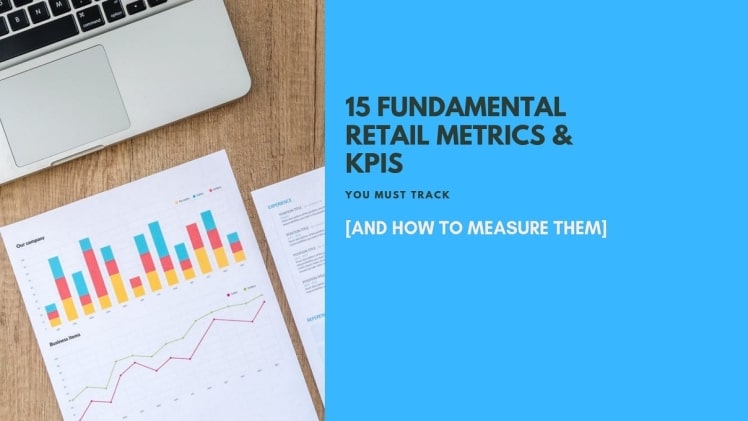A retail Key Performance Indicator (KPI) or metric is a well-defined and quantitative indicator that you can use to evaluate a store’s performance. Here are the top 25 for 2022. Some of these services may be included in their billings, but the distinction between a 3PL and a transportation company isn’t always easy to define.
Retail Key Performance Indicators (KPIs)
Sales Per Square Foot
The sales-per-square-foot measure compares a store’s income to the amount of floor area it takes up, indicating how efficient a location is.
Revenue/Selling Area = Sales per Square Foot
Year-over-year sales are a retail KPI.
Sales Year-Over-Year
Comparing quarterly sales to those of the prior year is the most popular approach to track sales.
Year-Over-Year Sales = ((Current Year’s Sales – Last Year’s Sales)/(Last Year’s Sales) * 100%
Average Transaction Value (ATV)
This retail indicator indicates how much a consumer spends on average during each visit. If clients are spending a lot of money, it might mean that your higher-value items are more popular, or that they are purchasing in huge amounts every time they come in.
Revenue/Number of Transactions Equals Average Transaction Value
Sales Per Employee
A little friendly rivalry among salespeople may be quite motivating. The retail KPI of Sales per Employee is an excellent approach to keep track of individual performance. These figures can then be utilized for performance evaluations, pay calculations, and training needs assessments.
Cost of Goods Sold (COGS)
What was the total cost of your merchandise? Have the prices risen or fallen over time? This indicator measures how much it costs to acquire or manufacture items in the retail sector. You can use this data to establish your rates, as well as for membership benefits and accounting records.
COGS = Cost of Goods Sold – Cost of Goods Sold
Online vs. In-Store Sales
If you operate both an online store and a physical store, you should keep note of how much money each source generates. This retail KPI might help you assess if both retail channels are essential or whether one is more efficient.
Shrinkage
The loss of inventory due to causes other than sales is known as shrinkage. Administrative mistakes, employee theft, shoplifting, and supplier fraud are all major causes of shrinkage.
Ending Inventory Value – Actual Inventory Value = Shrinkage
Sell Through
The sell-through retail indicator measures the proportion of units sold compared to the total number of units offered. This is a fantastic approach to assess a product’s performance and compare it to the performance of other items you offer.
(# of units sold/starting inventory) * 100% = Sell Through
Gross Margin Return on Investment (ROI)
The GMROI ratio is used to assess the profitability of your inventory. The higher the ratio, the bigger your product margins are.
Gross Profit/Average Inventory Cost = GMROI
If you’re looking for information on how to get started with your small-business success, then look no further! With these pointers on how to get started, you’ll soon see your small business thrive!
As a business owner, you can also consider getting insurance like small business insurance or public liability insurance nsw. These provide a layer of protection for your business.
Client Retention Rate
As many business owners are aware, acquiring a new customer is more expensive than keeping an existing one (which is why loyalty programs exist). This retail indicator measures the number of consumers that return to your business for a second visit (or more).
((Number of Customers at Period End – Number of New Customers During Period))/(Number of Customers at Period Start)*100%
Customer Satisfaction
Customer happiness and retention generally go hand in hand. However, accurate data to gauge consumer happiness is sometimes difficult to come by. Most firms try to entice clients to participate in surveys by offering an incentive.
Traffic
Traffic keeps track of how many people come into your business or visit your website. These figures can be used to assess the performance of a marketing campaign or a product launch. It may also be used to compare the popularity of different places when it comes to physical stores.
Units per Transaction
This retail KPI counts the number of things sold in a transaction. It comes in handy for analyzing sales trends (seasonal, promotions, etc.) or staff performance.
# of Units Sold/# of Transactions Equals Units per Transaction
Inventory Turnover
Measuring inventory turnover is one technique to measure your merchandising success with a KPI. Experiment with placing different goods in the front of your store or on the top page of your online marketplace to observe how it affects inventory turnover.
Inventory Turnover = Average Inventory at Cost/Cost of Goods Sold
Conversion Rate
We typically hear about conversion rates when discussing online businesses since they are easier to measure, but this retail metric is just as pertinent to brick-and-mortar establishments. The conversion rate indicator counts the number of visitors who become customers. This is widely used to assess the effectiveness of advertisements or promotions.
Number of sales divided by the number of visitors equals the conversion rate.
Dwell Time
How much time do customers spend at your store or on your website? Do you have any idea which part they spend the most time in? The merchandising KPI shopper-dwell-time is used to measure how much time each consumer spends in each segment. The more time someone spends looking at a product or exhibit, the more likely they are to buy it.
CTR (Click-Through Rate)
This is a retail measure that only applies to online marketplaces. It is used to analyse how effectively your marketing initiatives are doing. The CTR indicates how many times your ad was clicked against the number of times it was seen (impressions).
Operating Expenditures (OPEX)
Your operational expenses are all charges incurred in the day-to-day functioning of your firm. Rent, inventory, insurance, and payroll are just a few examples. Your OPEX will vary greatly depending on how you run your retail firm. A actual brick-and-mortar facility, for example, will cost a lot in rent, but an online firm that drop-ships things may not.
Quick Ratio
Probably the most popular ratio for quickly and easily assessing the health of your company. The fast ratio assesses your capacity to fulfil urgent liabilities without selling goods. A ratio greater than one is excellent and indicates strong financial health.
(Cash + Marketable Securities + Accounts Receivable)/Current Liabilities = Quick Ratio
Current Ratio
Current ratio gauges a company’s capacity to satisfy obligations in the same way that the quick ratio does. This ratio, on the other hand, adopts a more practical approach, determining if a corporation can satisfy its obligations within a year.
Current Assets/Current Liabilities = Current Ratio
Accounts Payable Turnover (APT)
APT is used by retail businesses to assess their cash flow situation by keeping track of how long it takes a firm to pay its suppliers.
Total Supply Purchases divided by ((Beginning AP – Ending AP)/2) = APT.
Days of Inventory Outstanding (DIO)
It’s critical to have a well-stocked inventory, but it’s also critical to keep your inventory moving. This retail KPI measures the time it takes for your inventory to convert to sales.
DIO = (Average Inventory Cost/COGS) * 365 Days DIO = (Average Inventory Cost/COGS) DIO = (Average Inventory Cost/CO
DSO (Days Sales Outstanding)
The time it takes to receive payment following a sale is measured by this financial KPI.
(Accounts Receivable/Total Credit Sales) * Number of Days in Period DSO = (Accounts Receivable/Total Credit Sales) DSO = (Accounts Receivable/Total Credit Sales) DSO
Days Payables Outstanding (DPO)
How long do you take to pay your vendors? This is similar to the DSO metric, only you’re assessing how long it takes you to pay your debtors.
(Accounts Payable * Number of Days in Period)/COGS DPO = (Accounts Payable * Number of Days in Period)/COGS
The Cash Conversion Cycle (CCC)
CCC delves further into the nitty gritty of retail accounting and financials. It computes the number of days it takes to convert products back to cash is measured by this retail performance parameter.
Days of Inventory Outstanding + Days of Sales Outstanding – Days Payables Outstanding CCC = Days of Inventory Outstanding + Days Sales Outstanding – Days Payables Outstanding CCC = Days of Inventory Outstanding + Days
Net Profit Margin
Do you realize how much money you’re making? The most crucial financial KPI for every organization, whether retail or not, is the net profit margin (often known as the bottom line). It calculates how much money you make in relation to your revenue. The greater the number, the more money you will make.
(Net Income/Net Sales) * 100% = Net Profit Margin

